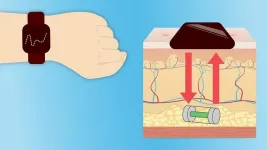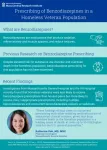(Press-News.org) Researchers at the University of Wisconsin–Madison have identified a protein key to the development of a type of brain cell believed to play a role in disorders like Alzheimer’s and Parkinson’s diseases and used the discovery to grow the neurons from stem cells for the first time.
The stem-cell-derived norepinephrine neurons of the type found in a part of the human brain called the locus coeruleus may enable research into many psychiatric and neurodegenerative diseases and provide a tool for developing new ways to treat them.
Yunlong Tao, an investigator at Nanjing University in China who was a research professor at UW–Madison’s Waisman Center when the study was performed, and Su-Chun Zhang, a UW–Madison professor of neuroscience and neurology, published their work on the cells, which they call LC-NE neurons, today in the journal Nature Biotechnology.
Norepinephrine neurons in the locus coeruleus regulate heartbeat, blood pressure, arousal, memory, attention and “fight or flight” reactions. Humans have approximately 50,000 LC-NE neurons in the hindbrain, where the locus coeruleus is. From there, the LC-NE neurons reach into all parts of the brain and the spinal cord.
“The norepinephrine neurons in the locus coeruleus are essential for our life. We call it the life center,” Zhang says. “Without these nerve cells, we would probably be extinct from Earth.”
These neurons also play a role, albeit unknown, in various neurodegenerative and neuropsychiatric diseases. In many neurodegenerative diseases such as Alzheimer’s and Parkinson’s, the neurons start degenerating at a very early stage — sometimes years before other brain regions begin to falter.
“People have noticed this for a long time, but they don’t know what the function of the locus coeruleus is in this process. And partly because we don’t have a good model to mimic the human LC-NE neurons,” says Tao, first author of the study.
Previous attempts at creating these neurons from human stem cells followed a protocol based on the development of LC-NE neurons in mouse models. For two years, Tao explored why these attempts were failing and how development of the neurons from stem cells was different in humans.
In the new study, he identified ACTIVIN-A, a protein that belongs to a family of growth factors, as important in regulating neurogenesis in human NE neurons.
“We have some new understanding about locus coeruleus development,” Tao says. “That’s the major finding in this paper, and based on that finding, we are able to generate locus coeruleus norepinephrine neurons.”
To create LC-NE neurons, the researchers converted human pluripotent stem cells into cells from the hindbrain. Then, using ACTIVIN-A and a series of additional signals, they steered cell development toward their fate as LC-NE neurons.
Once converted, the cells showed typical characteristics of functioning LC-NE neurons in the human brain, releasing the neurotransmitter norepinephrine. They also showed axonal arborization — extension of the long, branching arms of neurons that enable the connections between brain cells — and reacted to the presence of carbon dioxide, which is crucial for breathing control.
The new cells may serve as models for disease in humans, allowing scientists to screen drugs for potential treatments and answer questions such as why the cells in the locus coeruleus die so early in neurodegenerative diseases.
“If this is somewhat causative, then we could potentially do something to prevent or delay the neurodegeneration process,” Zhang says.
The LC-NE cells may someday serve as stem-cell therapy themselves.
“The application of these cells is quite broad in its significance,” Zhang says.
Next, the researchers plan to examine the detailed mechanisms through which ACTIVIN-A regulates LC-NE neuron development. The group will also use the cells for the translational work of drug screening and disease modeling.
This research was supported by grants from the National Institutes of Health (NS096282, NS076352, NS086604, U54 HD090256, HD106197 and 1S100OD018202-01), Aligning Science Across Parkinson’s, National Medical Research Council of Singapore, Ministry of Education of Singapore, Bleser Family Foundation and Busta Foundation.
###
— Charlene N. Rivera-Bonet, riverabonet@wisc.edu
END
Scientists produce human norepinephrine neurons from stem cells, with significant implications for researching diseases like Alzheimer’s and Parkinson’s
Researchers have identified a protein that is key to the development of a type of brain cell believed to play a role in disorders like Alzheimer’s and Parkinson’s diseases and used the discovery to grow the neurons from stem cells for the first time
2023-11-17
ELSE PRESS RELEASES FROM THIS DATE:
Cheap medicines prevented migraine as well as expensive ones
2023-11-17
Migraine is more than just a headache. Often the pain is accompanied by nausea, vomiting, light sensitivity, and sound sensitivity. Chronic migraine can be disabling and may prevent many, especially women, from contributing to working life.
Still, it often takes a long time for migraine patients to find a treatment that works well for them. Researchers at the Norwegian Center for Headache Research (NorHead) have used data from the Norwegian Prescription Register to look at which medicines best prevent migraine in people in Norway:
“There has now been done a lot of research on this subject ...
Study reveals surprising link between malnutrition and rising antibiotic resistance
2023-11-17
University of B.C. researchers have uncovered startling connections between micronutrient deficiencies and the composition of gut microbiomes in early life that could help explain why resistance to antibiotics has been rising across the globe.
The team investigated how deficiencies in crucial micronutrients such as vitamin A, B12, folate, iron, and zinc affected the community of bacteria, viruses, fungi and other microbes that live in the digestive system.
They discovered that these deficiencies led to significant shifts in the gut ...
New study reveals the genetics of human head shape
2023-11-17
Researchers at the University of Pittsburgh and KU Leuven have discovered a suite of genes that influence head shape in humans. These findings, published this week in Nature Communications, help explain the diversity of human head shapes and may also offer important clues about the genetic basis of conditions that affect the skull, such as craniosynostosis.
By analyzing measurements of the cranial vault — the part of the skull that forms the rounded top of the head and protects the brain — the team identified 30 regions of the genome associated with different aspects of head shape, 29 of which have not been reported previously.
“Anthropologists ...
Miniature device offers peace of mind for diabetics
2023-11-17
The first glucose self-monitoring system created in 1970 weighed three pounds, was initially designed only for physicians’ offices and needed a large drop of blood for a reading. Over 50 years later, researchers at Texas A&M University are working to create a fully injectable continuous glucose monitor (CGM) so small it rivals a grain of rice and can be used with an external optical reader to measure sugar levels at any given time.
While CGMs have advanced over the last 25 years, current models can still be a nuisance to the user and the required upkeep may discourage use. To address this issue, two faculty members from the Department of Biomedical Engineering ...
Argonne receives funding to advance diversity in STEM
2023-11-17
The U.S. Department of Energy (DOE) has awarded DOE’s Argonne National Laboratory funding as part of the Reaching a New Energy Sciences Workforce (RENEW) initiative, aimed at fostering diversity in STEM and advancing innovative research opportunities.
DOE announced $70 million to support internships, training programs and mentorship opportunities at 65 different institutions, including 40 higher-learning institutions that serve minority populations. By supporting these partnerships, DOE aims to create a more diverse STEM talent pool capable of addressing ...
Research spotlight: prescribing of benzodiazepines in a homeless veteran population
2023-11-17
What Question Were You Investigating?
Despite elevated risk for substance use disorder and overdose death in the homeless population, benzodiazepine prescribing for this population has not been examined.
Our team therefore set out to answer the questions:
What is the rate of benzodiazepine prescribing to homeless vs. non-homeless veterans with mental illness in the VA system?
Are homeless veterans more likely to receive risky and potentially inappropriate prescriptions?
What Methods Did You Use?
We used logistic regression to compare likelihood of benzodiazepine prescribing and t tests to compare ...
First human clinical trial for pill-sized device that monitors breathing from the gut
2023-11-17
Scientists have developed an ingestible device that can safely monitor vital signs like breathing and heart rate from inside humans. The tool, described November 17 in the journal Device, has the potential to provide accessible and convenient care for people at risk of opioid overdose.
“The ability to facilitate diagnosis and monitor many conditions without having to go into a hospital can provide patients with easier access to healthcare and support treatment,” says Giovanni Traverso, the first author of the paper, associate professor in the Department of Mechanical Engineering at the Massachusetts Institute of Technology and gastroenterologist at Brigham ...
Ingestible vital signs monitor shows promise in first-in-human trial
2023-11-17
What if, instead of going into a sleep lab or being connected to monitoring devices, a patient could have their risk of obstructive sleep apnea measured by swallowing a pill? A new collaborative study from Brigham and Women’s Hospital, a founding member of the Mass General Brigham healthcare system, Massachusetts Institute of Technology, Celero Systems and West Virginia University, evaluated a wireless ingestible device that can accurately report vital signs like heart and respiratory rate. The team tested the device, known as the Vitals Monitoring Pill (VM Pill), in a pilot ...
Putting an end to plastic separation anxiety
2023-11-17
Bio-based plastics such as polylactic acid (PLA) were invented to help solve the plastic waste crisis, but they often end up making waste management more challenging. Because these materials look and feel so similar to conventional, petroleum-based plastics, many products end up not in composters, where they break down as designed, but instead get added to the recycling stream by well-intentioned consumers. There, the products get shredded and melted down with the recyclable plastics, bringing down the quality of the mixture and making it harder to manufacture functional products out of recycled plastic resin. The only solution, currently, is to try to separate the different ...
Ingestible electronic device detects breathing depression in patients
2023-11-17
CAMBRIDGE, MA -- Diagnosing sleep disorders such as sleep apnea usually requires a patient to spend the night in a sleep lab, hooked up to a variety of sensors and monitors. Researchers from MIT, Celero Systems, and West Virginia University hope to make that process less intrusive, using an ingestible capsule they developed that can monitor vital signs from within the patient’s GI tract.
The capsule, which is about the size of a multivitamin, uses an accelerometer to measure the patient’s breathing rate and heart rate. In addition to diagnosing sleep apnea, the device could also be useful for detecting ...
LAST 30 PRESS RELEASES:
Making lighter work of calculating fluid and heat flow
Normalizing blood sugar can halve heart attack risk
Lowering blood sugar cuts heart attack risk in people with prediabetes
Study links genetic variants to risk of blinding eye disease in premature infants
Non-opioid ‘pain sponge’ therapy halts cartilage degeneration and relieves chronic pain
AI can pick up cultural values by mimicking how kids learn
China’s ecological redlines offer fast track to 30 x 30 global conservation goal
Invisible indoor threats: emerging household contaminants and their growing risks to human health
Adding antibody treatment to chemo boosts outcomes for children with rare cancer
Germline pathogenic variants among women without a history of breast cancer
Tanning beds triple melanoma risk, potentially causing broad DNA damage
Unique bond identified as key to viral infection speed
Indoor tanning makes youthful skin much older on a genetic level
Mouse model sheds new light on the causes and potential solutions to human GI problems linked to muscular dystrophy
The Journal of Nuclear Medicine ahead-of-print tip sheet: December 12, 2025
Smarter tools for peering into the microscopic world
Applications open for funding to conduct research in the Kinsey Institute archives
Global measure underestimates the severity of food insecurity
Child survivors of critical illness are missing out on timely follow up care
Risk-based vs annual breast cancer screening / the WISDOM randomized clinical trial
University of Toronto launches Electric Vehicle Innovation Ontario to accelerate advanced EV technologies and build Canada’s innovation advantage
Early relapse predicts poor outcomes in aggressive blood cancer
American College of Lifestyle Medicine applauds two CMS models aligned with lifestyle medicine practice and reimbursement
Clinical trial finds cannabis use not a barrier to quitting nicotine vaping
Supplemental nutrition assistance program policies and food insecurity
Switching immune cells to “night mode” could limit damage after a heart attack, study suggests
URI-based Global RIghts Project report spotlights continued troubling trends in worldwide inhumane treatment
Neutrophils are less aggressive at night, explaining why nighttime heart attacks cause less damage than daytime events
Menopausal hormone therapy may not pose breast cancer risk for women with BRCA mutations
Mobile health tool may improve quality of life for adolescent and young adult breast cancer survivors
[Press-News.org] Scientists produce human norepinephrine neurons from stem cells, with significant implications for researching diseases like Alzheimer’s and Parkinson’sResearchers have identified a protein that is key to the development of a type of brain cell believed to play a role in disorders like Alzheimer’s and Parkinson’s diseases and used the discovery to grow the neurons from stem cells for the first time






